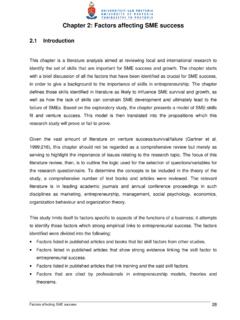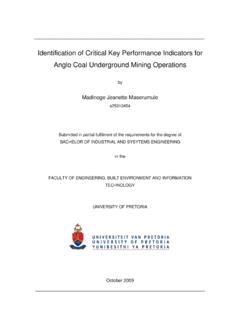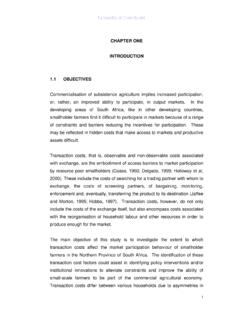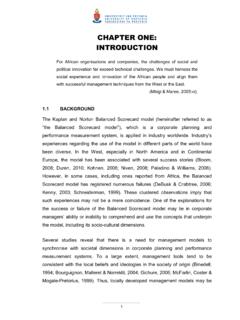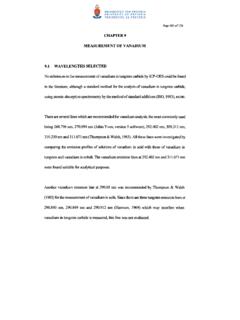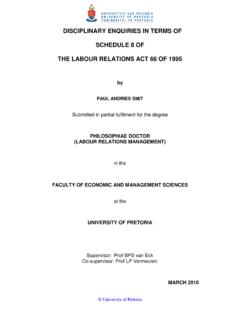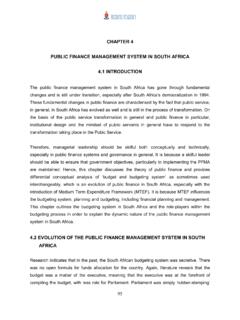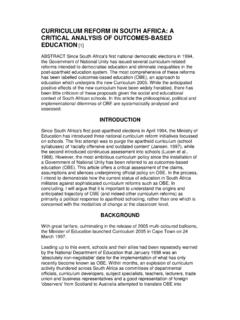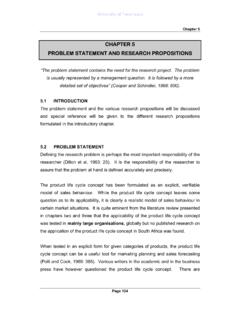Transcription of CHAPTER 2 2 ENTREPRENEURSHIP THEORY AND …
1 CHAPTER 2: ENTREPRENEURSHIP THEORY AND CREATIVITY CHAPTER 2 2 ENTREPRENEURSHIP THEORY AND CREATIVITY Introduction The purpose of this CHAPTER is to establish whether ENTREPRENEURSHIP THEORY provides guidelines, specifically through definitions of the domain, as to how the concepts creativity and innovation are linked to the domain and which subjacent constructs of the concepts creative and innovative can be identified as unique to the ENTREPRENEURSHIP domain. The CHAPTER layout is explained in Figure ENTREPRENEURSHIP THEORY Discussion of the subject domain Perspectives Small business owners versus entrepreneurs Key concepts ENTREPRENEURSHIP THEORY and creativity Content Analysis of definitions Testing result of content analysis quantitatively Figure : Layout of CHAPTER 2 In investigating the ENTREPRENEURSHIP domain it is helpful to establish the boundaries of the domain (Carton et al.)
2 1998:4): ENTREPRENEURSHIP begins with action, the creation of a new organisation in-cluding the antecedents to its creation, inter alia, scanning the environment for opportunity, the identification of the opportunity to be pursued, the evalua-tion of the feasibility of the new venture. 11 UUnniivveerrssiittyy ooff PPrreettoorriiaa eettdd KKrruuggeerr,, MM EE ((22000044)) CHAPTER 2: ENTREPRENEURSHIP THEORY AND CREATIVITY owth objectives for companies. 01:9). The second dimension of the ENTREPRENEURSHIP paradigm is venture performance. According to some authors, growth seems to be a typical characteristic of entrepreneurial ventures.
3 It is important to have a clear description of the term "growth". Quantitative growth can be characterised by the company size (turnover, added value, volume), the profitability of the company and the value of the company (shareholder value). Qualitative objectives are linked with the quantitative objectives, not as an aim in itself but as strategic means for the realisation of the growth of the enterprise. The competitive position, product quality and customer service are examples of qualitative gr In analysing various definitions of ENTREPRENEURSHIP , the researcher aims to find the ENTREPRENEURSHIP domain's delimitation of activities core to the domain.
4 It will also be attempted by means of counting the number of references to the concepts in citations and abstracts of periodical articles in the domain to establish its acceptance of creativity and innovation as core to ENTREPRENEURSHIP . The ENTREPRENEURSHIP Subject Domain ENTREPRENEURSHIP is a relatively young academic field in the early stages of its developmental cycle. This creates problems in defining the field and the scope of its research. There is also the lack of a unifying framework that distinguishes ENTREPRENEURSHIP from strategic management (Zahra & Dess 20 Plaschka and Welsch (1990:105) argue that the development of ENTREPRENEURSHIP as a discipline went through four fundamental phases before it was acknowledged as an acceptable academic subject.)
5 Systematic THEORY development The consensus surrounding an acceptable definition with regard to the acceptance of the fact that entrepreneurs can be trained, the movement towards more sophisti-cated research methods and statistical techniques, a move towards the usage of 12 UUnniivveerrssiittyy ooff PPrreettoorriiaa eettdd KKrruuggeerr,, MM EE ((22000044)) CHAPTER 2: ENTREPRENEURSHIP THEORY AND CREATIVITY 1987:151). 1:1). 167). 4:48). bigger samples, the division and attention to ENTREPRENEURSHIP and intrapreneurship form part of the THEORY development. Although there are several theories on ENTREPRENEURSHIP , there are very few mathematical models, which formally analyse entrepreneurial behaviour within a closed economic system.
6 It is often argued that ENTREPRENEURSHIP is by nature spontaneous and therefore entrepreneurial behaviour cannot be predicted using deterministic models (Eatwell, Milgate & Newman Most management researchers agree that currently there is not a single accepted definition of entrepreneur that has been uniformly accepted in the literature (Carlock 1994:18) (Grant & Perren 2002:186). Selecting an appropriate basis for defining and understanding ENTREPRENEURSHIP creates a challenge for academic researchers and writers due to the fact that a number of schools of thought exist that view the notion of ENTREPRENEURSHIP from fundamentally different perspectives.)
7 The term has been used to indicate a range of activities from creation, founding, adapting to managing a venture (Cunningham & Lischeron 199 Mainstreams of entrepreneurial research and its development One should look at the development of ENTREPRENEURSHIP from the classical viewpoint. Those authors and pioneers made a substantial contribution both towards the initial development and the later contemporary developments. Two basic trends can be observed in the field of ENTREPRENEURSHIP . The first stemmed from the work of Turgot and Say (1803) and considered the entrepreneur to be the person who creates and develops new businesses.)
8 The second takes the view of Cantillon and Schumpeter, namely that the entrepreneur is an innovator (Bruyat & Julien 2000: Say recognised the managerial role of the entrepreneur. In the business the entrepreneur acts as leader and manager because he plays an important role in coordinating production and distribution. Wealth was part of the process and was created by production. Say introduced a distinction between the supply of capital function and the enterprise function (Jennings 19913 UUnniivveerrssiittyy ooff PPrreettoorriiaa eettdd KKrruuggeerr,, MM EE ((22000044)) CHAPTER 2: ENTREPRENEURSHIP THEORY AND CREATIVITY 94:43).)
9 Roduction: try. Cantillon (1725) was the first to place the entrepreneurial function in the field of Economics. The principle of profit maximisation immediately became part of the definition of an entrepreneur. Cantillon argued that entrepreneurs were directly involved in the equilibrium of supply and demand (Jennings 19 Schumpeter, as referred to by Mourdoukoutas (1999:75), treated ENTREPRENEURSHIP as a distinct and separate function of the firm and identified five ways of revolutionising the pattern of p The development of a new product , a product never introduced before, or the substantial improvement of quality of an existing product.)
10 The discovery of a new production method. The term discovery does not necessarily mean scientific discovery but the genuine application of an existing method to an indus The discovery and exploitation of a new market. The term discovery does not necessarily apply to a new geographical market or an unknown market, but rather a market that an industry has not explored before. The discovery and exploitation of a new source of supply of raw materials. Again the term "discovery" does not necessarily apply to a new geographical resource market or an unknown resource, but rather a resource that was never used in a certain industry.
